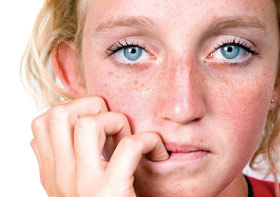When Children Grind Their Teeth
Is The Habit Of 'Bruxism' Harmful?

It's a screeching, gritting sound as unnerving as scraping fingernails across a blackboard. The first time you hear it in your sleeping child's bedroom you may wonder: What could possibly be going on in there? What a surprise to find that such a small person can make such a loud noise — and not even wake up!
Teeth grinding, or “bruxism,” is actually a very common habit among children, particularly those under age 11. It's so common, in fact, that it is often considered normal behavior. It is only when it causes severe tooth wear, pain, or trouble sleeping that it may rise to the level of a significant problem. Yet healthcare professionals do not always agree on how or when to treat bruxism — if at all. And the causes are not completely understood, though psychological stress appears to play an important role.
The Daily (Or Nightly) Grind
The term bruxism comes from the Greek “brychein” from which is derived “ebryxa,” to gnash the teeth. It was first used in 1931 to describe involuntary, excessive grinding, clenching, or rubbing of the teeth together. More recently, it has been further defined as a diurnal (during the day) or nocturnal (at night) parafunctional activity (“para” – outside, “function” – normal). It refers to movements of the teeth and jaws that are not necessary for functional activity — chewing, speaking or swallowing, for example. Repetitive parafunctional forces can damage the teeth when they occur through these quite unconscious habits.

Children are susceptible to various habits conducted without consciousness, such as nail and cheek biting and non-nutritive sucking. Parafunction when awake, which manifests as clenching and/or grinding of the teeth, often occurs without awareness, especially during stressful situations or intense concentration. When a child is made aware of it, the bruxism can be stopped or modified. On the other hand, a child cannot consciously stop bruxing while asleep.
Some Theories To Chew On
In healthy infants, sleep bruxism typically starts at about 1 year of age, soon after the front teeth come into the mouth. In young children, teeth grinding may be due to the immaturity of the neuromuscular system (“neuro” – nerves; “muscular” – muscles) that controls chewing.
Current thinking is that bruxism is part of an arousal response, defined as a sudden change from deeper to lighter sleep or awakening. In young adults, more than 80% of sleep bruxism episodes occur during periods of sleep known as stages 1 and 2 non-Rapid-Eye-Movement (REM) sleep, and only 5% to 10% in REM (deep) stages. Many of these episodes lead to a shift in sleep stage, usually toward awakening or lighter sleep.
Bruxism is prevalent in children who snore and/or breathe through their mouths. One theory suggests there is a correlation between sleep bruxism and upper airway obstruction, causing obstructive sleep apnea (“a” – without, “pnea” – breath), in which the tongue and tissues at the back of the mouth fall backwards and block the airway. Sleep apnea can be dangerous. It can lead to episodes of awakening throughout the night to gasp for air, interrupting restful sleep and growth, and depriving the brain of adequate oxygen. It appears to happen more often in children who sleep on their backs. A link has also been made between teeth grinding and enlarged tonsils, which in turn is strongly correlated to upper airway obstruction. Removing the tonsils and adenoids has been shown to lessen teeth grinding in some children. Asthma and respiratory airway infections may also be factors in bruxism.
 |
| Some medications, such as the most commonly prescribed antidepressants, may contribute to grinding habits. |
Some medications, such as the most commonly prescribed antidepressants, may contribute to grinding habits. The number of children taking this type of drug is growing, so this is an important factor to consider when treating children with bruxism. Hyperactivity is also associated with bruxism as are the amphetamines used for managing attention deficit hyperactivity disorder (ADHD).
In older teens, factors implicated in teeth grinding include smoking, alcohol, illicit drug use, as well as other medications, trauma and disease. In addition, a host of diseases among children have been linked to bruxism, such as cerebral palsy, Down syndrome, and epilepsy.

